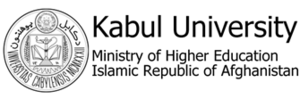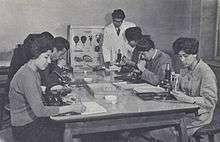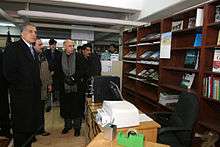Kabul University
 | |
| Latin: Universitas Cabulensis | |
| Motto | Excellence in Service to Afghanistan |
|---|---|
| Established | 1932 |
| Rector | = |
| Location | District 3, Kabul, Afghanistan |
| Colors | Black, red, and green |
| Website | www.ku.edu.af |
Kabul University (KU) (Pashto دکابل پوهنتون Da Kābul Pohantūn / Dari پوهنتون کابل Pohantūn-e Kābul) is located in Kabul, the capital of Afghanistan. It was founded in 1931 during the government of Mohammed Nadir Shah and then Prime Minister Mohammad Hashim Khan
Kabul University is attended by approximately 25,000 students, of which around 40% are women. The main building was renovated about 500 metres from the old one, which has almost the same design.
The mission of Kabul University is to mature and prosper as an internationally recognised institution of learning and research, a community of stakeholders committed to shared governance, and a centre of innovative thought and practice.
History

Kabul University was established in 1931 during the reign of Mohammed Nadir Shah and then Prime Minister Mohammad Hashim Khan, opening its doors one year later to students from across the country. It benefitted from partnerships with the governments of France, Germany, Russia, and the United States.[1]
In the 1960s foreign-educated scholars populated the campus, exposing the new generation to new topics such as communism, feminism and capitalism. Students influenced during this era included Ahmad Shah Massoud, Gulbuddin Hekmatyar, Dr. Faiz Ahmad, and Saydal Sokhandan.
Many different political groups were influenced in the university such as Khalqists, Parchamites, Sholayees, and Ikhwanists.
In a clash between Ikhwanis and Sholayees, a poet named Saydal Sokhandan was killed by Gulbuddin Hekmatyar in the 1970s. Saydal was fired upon and shot by Gulbuddin during an argument.[2]
During the governance of the People's Democratic Party of Afghanistan (PDPA), Kabul University lost several lecturers and staff. The majority of the university's faculty left during the ten-year period of unrest or civil war that followed after the fall of the PDPA government in 1992. The area around the university and Karte Char was a major battleground in the Afghan Civil War (1992-96).
Rebuilding

After the removal of the Taliban government in late 2001, the international community focused on rebuilding the educational institutions in Afghanistan. By January 2004 the campus had only 24 computers. As part of its recovery program the university has established partnerships with four foreign universities, including Purdue University and the University of Arizona. Furthermore, the Information Technology Center was founded in 2002 with the cooperation of German Academic Exchange Service (DAAD) and Technical University of Berlin. The number of students in higher education had increased across the country from 22,717 in 2002 to 56,451 in 2008. By 2008, the university was attended by 9,660 students, 2,336 (24%) of them being women.
It was reported in 2007 that Iran donated funds to the university's dentistry faculty and donated 25,000 books. The main library of Kabul University was built by the United States, which is the best-equipped library in Afghanistan. It is equipped with computers, books and magazines. Nancy Dupree, wife of Louis Dupree, was the Director of the Afghanistan Center at the university.
In 2008, the campus of Kabul University was provided with local network facilities by the Information Technology center of Kabul University (ITCK).[3] Each building is connected to the campus network and is provided with the internet connection from a fiber optic backbone. The Voice over IP (VoIP) technology was also part of the networking project, which improved the quality telephone communication at the university level.
Structure
- The Faculty of Environmental Science have Three Departments: Department of Environmental Protection, Department of Natural Resources Management and Department of Disaster Management.
- The Faculty of Law and Political Science has two departments: Law and Management, Political Science.
- The Faculty of Computer Science has three departments: department of Information Technology, department of Information System and department of Software Engineering.
- The Faculty of Economic has four departments - Statistics, Finance, Business Administration and Economics.
- The Faculty of Science has four departments: Biology, Chemistry, Mathematics and Physics.
- The Faculty of Engineering has five departments: Architecture, Civil, Mechanical, Electrical Engineering and Renewable Energy Engineering. An estimated 600 students are taking classes there.

- The Faculty of Pharmacy has five departments: Pharmacology, Pharmacology, Pharmaceutical Chemistry, Pharmaceutics and Biochemistry and Food Analysis. It has seven laboratories. An estimated 400 students are taking classes there.
- The Faculty of Agriculture has six departments: Agricultural Economics, Agronomy, Animal Science, Forestry and Natural Resources, Horticulture, and Plant Protection.
- The Faculty of Veterinary Science has five departments: Paraclinic Department, Preclinic Department, Clinic Department, Animal Husbandry Department, and Food Hygiene Department.
- The Faculty of Journalism has two departments: Radio and Television and Printing Press
- The Allama Iqbal Faculty of Arts built at a cost of around $10 million by neighboring country Pakistan, was established in 2010. The building contains 28 classrooms, two seminar-halls, a library, two computer labs, 20 faculty offices. It covers an area of 143,379 square feet (13,320.3 m2). Afghan and Pakistani officials inaugurated the building in July 2010.
Faculty of Computer Science
The faculty of Computer Science was separated from faculty of Natural Sciences in 2008. At that time the faculty had 17 lecturers, 215 students, 3 modern and equipped laboratories, one library, examination centre for long-distance exams, and was part of the CISCO regional project. The faculty has started lectures with three departments namely software engineering, information system and technology and database in 2010. The computer sciences faculty has close contacts with the University of Maryland, University of Washington, University of Cape Town, Technical University of Berlin and the computer sciences department of all domestic universities. The graduates of the faculty can work in information technology centers of all governmental and non-governmental organizations.[4]
National Centre for Policy Research
The National Centre for Policy Research was established at Kabul University by the Ministry of Higher Education and Konrad Adenauer Foundation in 2003, and includes faculty in the departments of Law and Politics, Economics, and Social Science.[5][6]
Library
In 1992, the library held 200,000 books, 5,000 manuscripts, 3,000 rare books, periodicals, photographs and calligraphic specimens. Following a civil war, most materials were sold in book markets, burnt, destroyed, or lost.[7] It served as the National Library of Afghanistan.
Notable alumni
- Ahmad Shah Massoud, political and military leader
- Wasef Bakhtari, professor and poet
- Hamida Barmaki, law professor and Child Rights Commissioner
- Nancy Dupree, expert on the history of Afghanistan
- Mawlana Faizani, philosopher and reformer
- Saeed Nafisi, professor
- Qadria Yazdanparast, legal advisor, human rights activist, Afghan Member of Parliament, head of Afghan Women High Association
- Mohammad Najibullah, President of Afghanistan (1987-1992)
See also
References
- ↑ "Tunes of hope at Kabul University". BBC News. 6 December 2001.
- ↑ www.maoism.ru - Glossary of Names and Terms mentioned in the Historical Overview Archived 16 July 2011 at the Wayback Machine.
- ↑ Archived 17 August 2011 at the Wayback Machine.
- ↑ "Brief history of Computer Science Faculty of Kabul University". Islamic Republic of Afghanistan Ministry of Higher Education Kabul University. Archived from the original on 19 June 2012. Retrieved 17 June 2012.
- ↑ "Activities of Policy Research National Center of Kabul University," Kabul University website Archived 22 October 2012 at the Wayback Machine. (accessed 2 January 2013)
- ↑ National Centre for Policy Research website (accessed 2 January 2013)
- ↑ The Situation of Kabul University Library: Its Past and Present Archived 5 November 2011 at WebCite
External links
| Wikimedia Commons has media related to Kabul University. |